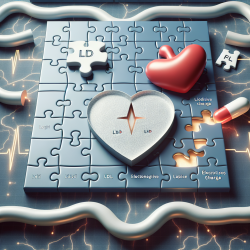Why Electronegative LDL Could Be the Missing Piece in Treating Cardiovascular Disease!

Despite the numerous risk factors for atherosclerotic cardiovascular diseases (ASCVD), cumulative evidence shows that electronegative low-density lipoprotein (L5 LDL) cholesterol is a promising biomarker. This article delves into the clinical significance of L5 LDL and how practitioners can use this knowledge to improve patient outcomes.
Understanding Electronegative LDL
Electronegative LDL (L5 LDL) is a subfraction of LDL cholesterol characterized by its higher electronegativity. Unlike traditional LDL, which is neutral or slightly positive, L5 LDL is more atherogenic and proinflammatory. Studies have shown that elevated levels of L5 LDL correlate with increased severity of cardiovascular diseases, making it a critical biomarker for ASCVD.
Clinical Significance of L5 LDL
The clinical applications of L5 LDL levels in ASCVD are profound. Research indicates that when L5 LDL levels exceed 1.7 mg/dL, the risk of clinically relevant ASCVD significantly increases. For patients with elevated L5 LDL, lipid-lowering treatments, including statins, ezetimibe, or PCSK9 inhibitors, may be required, irrespective of traditional LDL-C levels.
Implementing Research Outcomes
Practitioners can leverage the following insights from the research on L5 LDL to improve patient outcomes:
- Risk Stratification: Incorporate L5 LDL measurements in routine cardiovascular risk assessments to identify high-risk patients early.
- Therapeutic Threshold: Initiate lipid-lowering treatments for patients with L5 LDL levels greater than 1.7 mg/dL, even if their LDL-C levels are within the acceptable range.
- Further Research: Encourage research on rapid quantification methods for L5 LDL to facilitate large-scale epidemiological studies and develop targeted therapeutic strategies.
Encouraging Further Research
While the current findings are promising, more research is needed to fully understand the role of L5 LDL in cardiovascular diseases. Practitioners should stay updated on the latest research and consider participating in studies that explore new diagnostic and therapeutic approaches targeting L5 LDL.
Conclusion
The identification of L5 LDL as a significant biomarker for ASCVD opens new avenues for risk assessment and treatment. By integrating these insights into clinical practice, practitioners can enhance patient outcomes and contribute to the evolving field of cardiovascular medicine.To read the original research paper, please follow this link:
Clinical Significance of Electronegative Low-Density Lipoprotein Cholesterol in Atherothrombosis.
Citation: Chu, C.-S., Law, S. H., Lenzen, D., Tan, Y.-H., Weng, S.-F., Ito, E., Wu, J.-C., Chen, C.-H., & Ke, L.-Y. (2020). Clinical Significance of Electronegative Low-Density Lipoprotein Cholesterol in Atherothrombosis. Biomedicines, 8(8), 254. https://doi.org/10.3390/biomedicines8080254










